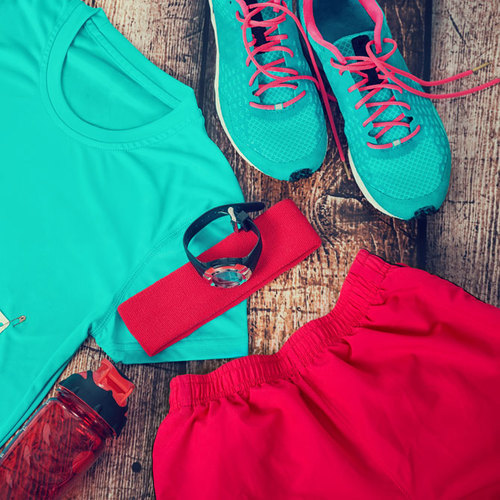Gear up for Success

Many who are new to fitness choose running or walking to get their feet wet because there’s no huge membership fee, no big equipment to buy, and often they can do it in their neighborhoods or a nearby park. Those are definitely perks to running and walking; however, there are a few very important basic gear items that are worth your investment.
Many new runners start running in the sneakers they have on hand. They look pretty good. They’re clean. The tread is still good. The problem is that these shoes may be great for casual knocking-around, but might not be best for fitness walking or running. As a coach to hundreds of beginning running over the years, I often hear, “Well, I’m not going to invest in an expensive pair of running shoes until I know I’m going to like it and stick with it.” The problem with this approach is that you’re drastically decreasing your chance of an optimal beginning running experience if you start out with ill-fitting or worn-out shoes.
Investment in proper running attire will increase your chance of a more comfortable experience and decrease your chance of injury. Below are some tips for getting some basic gear to help you have he best beginning running/walking experience possible.
Must-Haves:
1. Get Fitted: Pay a visit to your local specialty running store. Often these smaller stores have a more knowledgeable staff than the big box retail stores. Many provide gate analysis which reveals your foot strike pattern. Knowing this will determine whether you overpronate, underpronate or have a neutral gate—which will help in selecting the best shoe for your foot type. Be prepared to pay $80 to $130 for a good pair of running shoes. A good running store will determine your foot type, then bring out several different brands of shoes that support your foot type for you to try on.
Never let a sales person push a particular shoe on you. Try on as many shoes as needed for your foot type. Walk and run around the store. The pair that feels best on your feet is the pair you should buy. There is no one perfect running shoe. Each runner’s foot is as unique as each runner’s personality. Also, keep in mind that sometimes the “cute” or “cool” shoe may not be what’s best for your foot. Go for comfort and support, ot style.
2. Get Technical: Invest in technical fabric running shorts, running skirts, tops, and socks. Technical fabric can be made of a variety of fibers including natural (bamboo, SmartWool®) and synthetic (polyester, nylon, Lyrca®). Some popular branded technical fabrics include CoolMax® and DryFit®. Avoid 100% cotton. It tends to retain sweat, causing chaffing, irritation, and even blisters. Technical fabrics allow the moisture to rise to the surface where it can evaporate. They still get damp, but not nearly as much as 100% cotton. Close-fitting sport socks made of technical fibers will help decrease the chance of blisters. There is no need to spend a fortune on technical running clothes. Many stores (such as Target) carry affordable athletic brands like Champion.
Optional:
1. Hydration Bottle/Belt: You’ll be walking and/or running for 30-45 minutes, so carrying a hydration bottle is not required. However, for many beginning runners and walkers, carrying a handheld hydration bottle or wearing a hydration belt helps them feel more secure. Also, on really hot/humid days, being able to rinse the mouth with cool water can often be a comfort.
2. GPS Smart Phone App or GPS Watch: This is totally optional, but you may find it helpful to monitor your progress by tracking your mileage, shoe wear, total distance, and pace by using a GPS fitness app for your smart phone. Popular apps include Strava, RunKeeper, and MayMyRun. If you find you don’t like carrying your phone when running, then a GPS watch will allow you to

